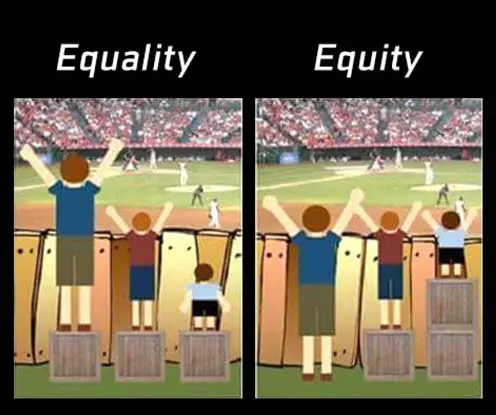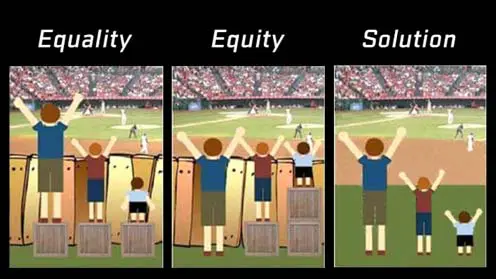RISE MODULE: EQUALITY VS. EQUITY
Activity: Visualizing Equality vs. Equity
Download as PDFObjectives:
- Define equality and equity, and explain the difference.
- Understand the process of how equality and equity can be used to achieve fairness.
Duration: 40 minutes
Materials:
- Equality and equity graphics
- Paper and drawing utensils (one per participant)
"Equality is giving everyone the same pair of shoes.Equity is giving everyone a pair of shoes that fits." — Author unknown
Facilitator Background:
Though often used interchangeably, equality and equity are quite different. If fairness is the goal, equality and equity are two processes through which we can achieve it. Equality simply means everyone is treated the same exact way, regardless of need or any other individual difference. Equity, on the other hand, means everyone is provided with what they need to succeed. In an equality model, a coach gives all of his players the exact same shoes. In an equity model, the coach gives all of his players shoes that are their size.
Facilitator Instructions:
- Begin by briefly explaining the difference between equality and equity. Be sure to state the guiding quotation: “Equality is giving everyone the same pair of shoes. Equity is giving everyone a pair of shoes that fits.”
- Next, without providing an explanation, display the first equality vs. equity image.
- Challenge participants to explain the similarities and differences in the image and how they represent equality and equity.
- Once participants grasp the concepts, prompt them to use their imagination and the paper and writing utensils provided to draw a third image of what an ideal solution to the scenario would look like.
- Encourage discussion of the drawings in pairs or small groups before inviting two or three participants to present to the larger group. Ask the group to vote for the drawing they think provides the best solution.
- After voting, display the image below to show one version of a solution.
- Facilitate a debrief using the questions below.

Image reprinted with permission from Craig Froehle, Ph.D.
Discussion Questions:
- Looking at the images, why does the difference between equity and equality matter?
- How does the baseball game metaphor relate to the guiding quote about shoes?
- What are some other real-world examples of equity and equality?
- How are equality and equity related to fairness? In school, sports, society, etc.?
- Are there other ways to achieve fairness besides equity and equality? (For example, the removal of the wooden fence eliminates the structural barrier to access.)

Concept Definitions:
- Equality is one of the central principles of democracy and is based on the belief that all people should have the same opportunities to be successful and have a productive, enjoyable life. Equality is rooted in fairness since it is linked to another American ideal, that of a meritocracy. The idea of equality is key to the notion that everyone will be able to achieve based on their efforts and contributions to society instead of their status or position. Equality was particularly important during the civil rights era when nonwhites didn't have equal standing or treatment before the law. More recently there has been a debate about whether equality is enough and whether equity is a more important principle.
- Equity recognizes that everyone doesn't begin in the same place in society. Some people face adverse conditions and circumstances making it more challenging with the same effort to achieve the same goals. Equity advocates for those who may have been historically disadvantaged, making it difficult for them to be successful. What is “fair” as it relates to equity isn't a question of what is the same but rather the point from which a person begins. Equity takes into account historical and other factors in determining what is fair.
Key Takeaways:
- Equity and equality are different.
- Equality means everyone is treated the same exact way, regardless of differences.
- Equity means everyone is provided with what they need to succeed.
Next Steps: Take the following actions after completing the activity with your team.
- Share photos on social media and tag/mention RISE.
- Facebook: @RISEtoWIN
- Instagram: @RISEtoWIN
- Twitter: @RISEtoWIN
- Snapchat: @RISEtoWIN
- Discuss your experience with students, athletes, coaches, athletic department staff and other organization members. Identify ways you and your school/organization can help lead the way in improving race relations and driving social progress.
Feedback:
RISE welcomes feedback as we seek to continually improve our tools and resources. We encourage allparticipants to share their feedback by completing an online survey at bit.ly/risetools. Our Leadership &Education Programs team can be reached at education@RISEtoWIN.org.
This module is an adaptation of #the4thBox Cut-out Edition activity from the Interaction Institute for Social Change.
Our
Partners
Stay
In Touch
Follow us on social media.